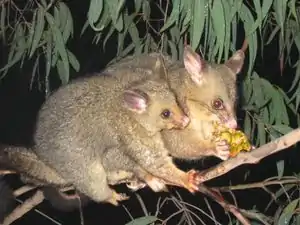Phalangeridae
The Phalangeridae are a family of mostly nocturnal marsupials native to Australia, New Guinea and Eastern Indonesia, including the cuscuses, brushtail possums, and their close relatives. Considered a type of possum, most species are arboreal, and they inhabit a wide range of forest habitats from alpine woodland to eucalypt forest and tropical jungle. Many species have been introduced to various non-native habitats by humans for thousands of years.[2]
| Phalangeridae[1] | |
|---|---|
 | |
| Common brushtail possum | |
| Scientific classification | |
| Kingdom: | Animalia |
| Phylum: | Chordata |
| Class: | Mammalia |
| Infraclass: | Marsupialia |
| Order: | Diprotodontia |
| Superfamily: | Phalangeroidea |
| Family: | Phalangeridae |
| Genera | |
Characteristics
Phalangerids are relatively large, compared with other possums. The smallest species, the Sulawesi dwarf cuscus, is cat-sized, averaging 34 cm (13 in) in length, while the largest, the black-spotted cuscus, is around 70 cm (28 in) long, and weighs 5 kg (11 lb). Besides the large size, other key features distinguishing phalangerids from other possums include the presence of bare skin on at least part of the tail, and low-crowned molar teeth. They have claws on the fore feet, but none on the hind feet, although these do have an opposable first toe to help grip onto branches. Additionally, in all but one species, both the first and second digits of the fore feet are opposable. The fur is typically dense or woolly, and may be grey, black, or reddish-brown, often with spots or stripes.[3]
Most phalangerids are folivores, feeding primarily on leaves. Like some similar species, they have a large cecum to ferment this highly fibrous food and extract as much nutrition as possible. However, their teeth are not as highly adapted to this diet as in other possums, and they also eat fruit, and even some invertebrates. The only exception to these general rules is the ground cuscus, which is carnivorous, and is also less arboreal than other phalangerid species.[3] The dental formula of phalangerids is:
| Dentition |
|---|
| 3.1.1.4 |
| 2.0.1-2.4 |
Gestation in phalangerids lasts 16–17 days in those species so far studied. The females have a well-developed pouch, and typically raise only one or two young at a time, less than many other possums. The adults are typically solitary, defending territories marked by scent-gland spray, odiferous saliva, urine, or dung.[3]
Most possums conserve the functions of the epipubic bones. The exception is Trichosurus, which remarkably among marsupials has shifted the hypaxial muscles from the epipubic to the pelvis, employing a more placental-like breathing, having lost the benefits of the epipubic in regards to lung ventilation. In general, these possums are more terrestrial than other members of this group, and resemble terrestrial primates in some respects.[4]
Classification
This classification is based on Ruedas & Morales 2005. The family Phalangeridae consists of six genera and 28 species.[1]
- Subfamily Ailuropinae
- Subfamily Phalangerinae
- Tribe Phalangerini
- Genus Phalanger
- Gebe cuscus (Phalanger alexandrae)
- Mountain cuscus (Phalanger carmelitae)
- Ground cuscus (Phalanger gymnotis)
- Eastern common cuscus (Phalanger intercastellanus)
- Woodlark cuscus (Phalanger lullulae)
- Blue-eyed cuscus (Phalanger matabiru)
- Telefomin cuscus (Phalanger matanim)
- Southern common cuscus (Phalanger mimicus)
- Northern common cuscus (Phalanger orientalis)
- Ornate cuscus (Phalanger ornatus)
- Rothschild's cuscus (Phalanger rothschildi)
- Silky cuscus (Phalanger sericeus)
- Stein's cuscus (Phalanger vestitus)
- Genus Spilocuscus
- Genus Phalanger
- Tribe Trichosurini
- Genus Trichosurus
- Genus Wyulda
- Tribe Phalangerini
Vernacular names
Blust (1982, 1993, 2002, 2009)[5][6][7][8] reconstructs the form *kandoRa ‘cuscus’ for Proto-Central–Eastern Malayo-Polynesian (i.e., the reconstructed most recent common ancestor of the Central–Eastern Malayo-Polynesian languages), but the validity of this reconstruction is doubted by Schapper (2011).[2]
Schapper (2011) shows that reconstructed forms for ‘cuscus’ are in fact quite diverse, and cannot be reconstructed to Proto-Central–Eastern Malayo-Polynesian. Other names for ‘cuscus’ are:[2]
- Proto-Timor: *madar
- Proto-Southeast Maluku: *mander
- Proto-Central Maluku: *mansər
- Proto-Oceanic: *kadroRa; there was a semantic shift from ‘cuscus’ to ‘bandicoot’ (Peramelidae) from Proto-Central–Eastern Malayo-Polynesian to Proto-Oceanic for the form *mans(a,ə)r.
- Proto-South Halmahera: *do
- Proto-Aru: *wagal
- North Bomberai languages:
- Proto-North Halmahera (non-Austronesian): *kusoro
Other local names for the cuscus are:[2]
- Central Maluku: Hila makel, Manipa marele, Wakasihu marilu, Hitu makel, Kailolo makele, Katu makello, Larike máridu, Nuaulu mara(ne)
- Timor: Kemak mada, Tetun meda, Mambae mat, Galoli madar, Waima'a meda, Uab Meto urem, Roma mada, Wetar maʧa
- Bird's Head Peninsula: Irarutu jemoga, Meoswar musiew, Ansus amu, Warembori maje
References
| Wikimedia Commons has media related to Phalangeridae. |
- Groves, C. P. (2005). Wilson, D. E.; Reeder, D. M. (eds.). Mammal Species of the World: A Taxonomic and Geographic Reference (3rd ed.). Baltimore: Johns Hopkins University Press. pp. 45–50. ISBN 0-801-88221-4. OCLC 62265494.
- Schapper, Antoinette (2011). "Phalanger Facts: Notes on Blust's Marsupial Reconstructions". Oceanic Linguistics. 50 (1). doi:10.1353/ol.2011.0004.
- Dickman, Christopher R. (1984). Macdonald, D. (ed.). The Encyclopedia of Mammals. New York: Facts on File. pp. 850–855. ISBN 0-87196-871-1.
- Reilly SM, McElroy EJ, White TD, Biknevicius AR, Bennett MB, Abdominal muscle and epipubic bone function during locomotion in Australian possums: insights to basal mammalian conditions and Eutherian-like tendencies in Trichosurus, J Morphol. 2010 Apr;271(4):438-50. doi: 10.1002/jmor.10808.
- Blust, Robert. 1982. The linguistic value of the Wallace Line. Bijdragen tot de Taal-, Land- en Volkenkunde 138:231–50.
- Blust, Robert. 1993. Central and Central-Eastern Malayo-Polynesian. Oceanic Linguistics 32:241–93.
- Blust, Robert. 2002. The history of faunal terms in Austronesian languages. Oceanic Linguistics 41:89–139.
- Blust, Robert. 2009. The position of the languages of eastern Indonesia: A Reply to Donohue and Grimes. Oceanic Linguistics 48:36–77.
- Ruedas, L.A. & Morales, J.C. 2005. Evolutionary relationships among genera of Phalangeridae (Metatheria: Diprotodontia) inferred from mitochondrial data. Journal of Mammalogy 86(2):353-365.